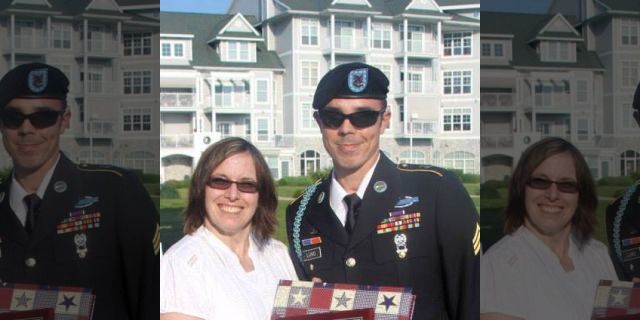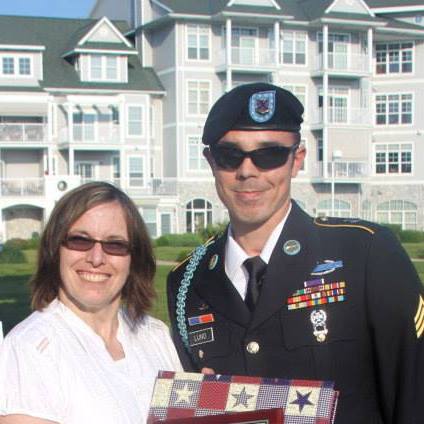[ad_1]
It took Eric Lund a few months after he woke up in a San Antonio hospital to understand that he’d lost both of his arms.
Lund, an Army National Guard Sgt., was injured in a roadside bomb explosion in May 2012 while serving in Afghanistan. In addition to losing his arms, he suffered a brain injury that affected how he processed new information.
In Nov. 2017, the 35-year-old became the first patient in the U.S. to undergo a double above-the-elbow arm transplant. Now, almost one year later, he has regained movement in his fingers, and his left hand can pick up foam blocks. His progress is featured in an episode of “The Innovators.”
“Eric lost both arms at a very high level, which means it’s closer to the shoulders than the wrist,” Dr. W.P. Andrew Lee, professor and director of the department of plastic and reconstructive surgery at Johns Hopkins University School of Medicine, and Lund’s lead surgeon, told Fox News. “The level of transplantation influences the timing of recovery because every time we do a transplantation, the nerves need to regrow from where the nerves are reconnected all the way down to the fingertips and that’s a process that takes time.”
MOM SAYS DAUGHTER ‘SCREAMED BLOODY MURDER’ AFTER TOUCHING POISONOUS CATERPILLAR
Lee said it’s estimated that nerves regrow at one inch per month, meaning that Lund is not expected to fully regain sensation in his arms for up to three years. Lee added that while it may seem like a longer period than for a hand transplant, his patient’s recovery is “well on course” to restore motor and sensory function.
“The biggest thing I’m working toward is getting used to the hands,” Lund, who enlisted in the military at age 19 after the Sept. 11 terror attacks, told Fox News. “I do a lot of exercises and various strengthening.”
Lund, who received two Purple Hearts and is now running for local office in his hometown of Ludington, Mich., and wants to return to school and eventually own a business, said that before the surgery he was trying to make life as normal as he could. It was his aunt who had mentioned the potential for a double arm transplant, and who eventually connected him with Dr. Lee, a member and past board member of the American Society of Plastic Surgeons.
Lee and Lund spoke by phone and eventually met in person while Lund continued rehabilitation at the Center for the Intrepid in San Antonio. Lund was then on his way to Johns Hopkins for further testing, which included medical, physical and psychological.
“We met his family and our team became convinced that he was an excellent candidate for transplant despite such a high-level of transplantation,” Lee said.

Lund, who was connected with Dr. Lee through his aunt, attends physical therapy for multiple hours a day.
(Courtesy)
Then came the waiting game for Lund. He returned home and was active in the community, played soccer, and tried not to concentrate on if the call for a potential donor would come.
The call did eventually come in November when he was home watching basketball. He was told there was a 4:30 p.m. flight to Baltimore that he needed to be on in order for it to happen.
FRANCE INVESTIGATES REPORTS OF BABIES BORN WITHOUT ARMS IN RURAL AREAS
Once there, four different surgical teams, each dedicated to an arm, were involved in the transplant surgery, and the 14 hours of careful reconstruction that followed.
But he’s not out of the woods yet. Lund is constantly monitoring his arms for signs of rejection and is on a regimen of immunosuppressant medication.
“Any transplant recipient, whether it’s kidney, liver or arms, are at risk of some rejection,” Lee said. “When it comes to arms, we have the advantage of seeing the part, when it’s an organ, it’s not visible.”
Lee said signs of rejection could manifest as a rash, redness or swelling, which gives Lund the ability to flag the team. Lee said many times the symptoms can be treated with a topical cream or an adjustment to the immunosuppressant medication that reverses the rejection.
Lee, who works with the Department of Defense to treat soldiers with upper extremity loss, said he hopes procedures like Lund’s become more mainstream. Lund’s surgery is considered part of a research project which means the cost of the procedure and recovery was covered.
“People with such high level of amputation above-the-elbow really don’t have good options when it comes to prosthetics, and when you have double arm amputation it limits functionality even more,” he said. “We believe arm transplantation at a high level can help restore function, and we hope that it will be more well-known by everyone, and then something that the insurance companies will cover in the future.”
[ad_2]
Source link

